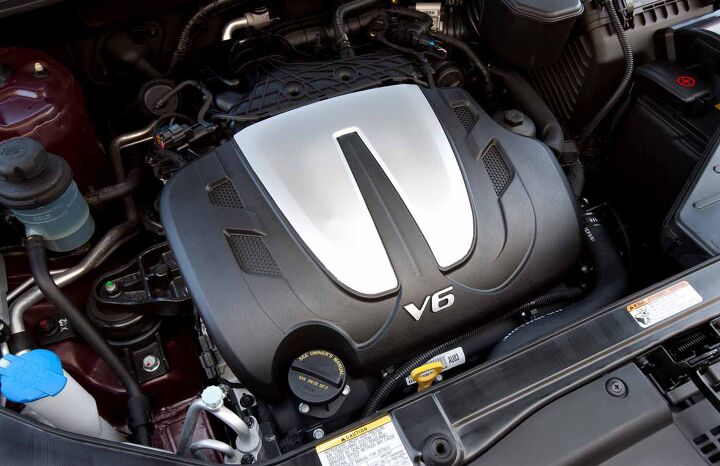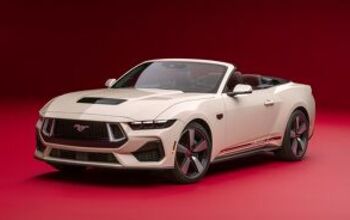Should I Buy a Used Hyundai Santa Fe?

For 2007, Hyundai introduced its second-generation Santa Fe crossover with an all-new platform and smoother styling. Starting with the 2007 model year, the Santa Fe grew in size, bringing an optional third row of seats.
Two V6 engines were available: a 2.7-liter with 185 hp and 183 lb-ft of torque or a 3.3-liter with 242 hp and 226 lb-ft. The smaller of those was offered with a five-speed manual transmission or a four-speed automatic while the 3.3-liter V6 came exclusively with a five-speed auto.
Both engine sizes were available in front- and all-wheel drive configurations although the five-speed stick only came powering the front set.
In 2010, Hyundai refreshed the Santa Fe (pictured) with two new engines. The 2.7-liter V6 was replaced by a 2.4-liter four-cylinder with 175 hp and 169 lb-ft of torque. The 3.3-liter V6 was replaced by a 3.5-liter unit with 276 hp and 248 lb-ft of torque. Both engines brought efficiency gains over the units they replaced, partly due with the fact that Hyundai switched transmissions.
Trims and packages:
Hyundai offered three trim levels: GLS, SE and Limited. The base GLS trim came with the smaller engine while the SE and Limited were offered exclusively with the more powerful V6. Each of the trim levels could be ordered with the third row when the second-generation Santa Fe debuted.
Top 3 Reasons to Buy:
1. Affordability – Like all Hyundai products, the Santa Fe competed as much on price as it did anything else. You should be able to find early models for under $10,000 without very much difficulty.
2. Practicality – With an admittedly cramped third row, you have the benefit of flexible seating capacity.
3. Warranty – Hyundai offers a five-year, 60,000 mile warranty on its vehicles and a 10-year 100,000 mile limited powertrain warranty, so you can probably find a Santa Fe that’s still covered.
Top 3 Problem Areas:
1. Frequent recalls – The second-generation Santa Fe went though 10 recalls ranging from minimal issues like improper labels to a call back on front-wheel drive models with the 2.4-liter four-cylinder and automatic transmission from 2010. The automatic is prone to being damaged and that can lead to power loss.
2. The recall mentioned in the last point is specific to the 2010 model year, but owners with cars from many other years also complain that their vehicles suffer from power loss. Many owners who filed complaints with the National Highway Traffic Safety Administration (NHTSA) say their vehicles frequently stall.
3. Transmission issues – Aside from the official recall in point one, complaints filed with NHTSA frequently describe harsh shifts where the post-refresh six-speed automatic transmission is seeming to struggle in changing gears.
Before you buy:
The Santa Fe might be a tempting choice because you can probably find them at a price discount compared to other crossovers of similar size and capability.
Keep in mind that at the time of writing, government documents show almost 900 owner complaints filed about the Santa Fe.
Based on those complaints, the second-generation Santa Fe seems to suffer from several quality issues, some of which could be dangerous.
A common complaint among owners with models from the 2007 to 2009 (pre refresh) is that the gas gauge doesn’t always accurately represent how much fuel is in the tank. Hyundai generally fixed the issue under its warranty.
Stalling is a common complaint among owners with models from 2010 to 2012.
Best Bang for Your Buck:
Santa Fes sold from 2007 to 2009 fell under recalls more frequently, but the issues most owners complain about aren’t as serious. Considering how many common problems owners are reporting, it’s probably better not to buy a used second generation Santa Fe without reliable warranty protection. Santa Fes from the 2009 model year and later are either already out of warranty or will be very soon. Bear in mind that even if you buy a vehicle that is under warranty, there is no guarantee that potential issues with the car will be addressed. First, the dealership service department needs to replicate the issue and some owners say the sporadic nature of the problems they describe makes it difficult to do that.
Recall and Crash Test Database
IIHS crash test ratings:
2007 Hyundai Santa Fe IIHS crash test scores
2008 Hyundai Santa Fe IIHS crash test scores
2009 Hyundai Santa Fe IIHS crash test scores
2010 Hyundai Santa Fe IIHS crash test scores
2011 Hyundai Santa Fe IIHS crash test scores
2012 Hyundai Santa Fe IIHS crash test scores
NHTSA Crash Test Rating:
2007 Hyundai Santa Fe NHTSA crash test rating
2008 Hyundai Santa Fe NHTSA crash test rating
2009 Hyundai Santa Fe NHTSA crash test rating
2010 Hyundai Santa Fe NHTSA crash test rating
2011 Hyundai Santa Fe NHTSA crash test rating
2012 Hyundai Santa Fe NHTSA crash test rating
NHTSA Recall Notices:
Search by campaign ID by clicking here.
2007 – 2011: Santa Fe: brake lights
2007 – 2009: Non-deploying front passenger air bag
2007 – 2008: Non-deploying driver’s air bag
2007: Malfunctioning rear brake lights
2007 – 2008: Malfunctioning trailer hitch wiring
2007 – 2008 tire labeling requirements
Model year unspecified – Thin fuel tanks

Luke is an energetic automotive journalist who spends his time covering industry news and crawling the internet for the latest breaking story. When he isn't in the office, Luke can be found obsessively browsing used car listings, drinking scotch at his favorite bar and dreaming of what to drive next, though the list grows a lot faster than his bank account. He's always on <A title="@lukevandezande on Twitter" href="http://twitter.com/lukevandezande">Twitter</A> looking for a good car conversation. Find Luke on <A title="@lukevandezande on Twitter" href="http://twitter.com/lukevandezande">Twitter</A> and <A title="Luke on Google+" href="http://plus.google.com/112531385961538774338?rel=author">Google+</A>.
More by Luke Vandezande

































Comments
Join the conversation